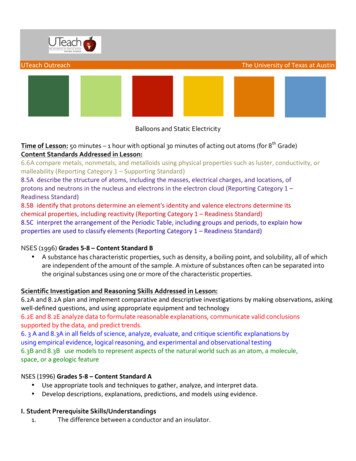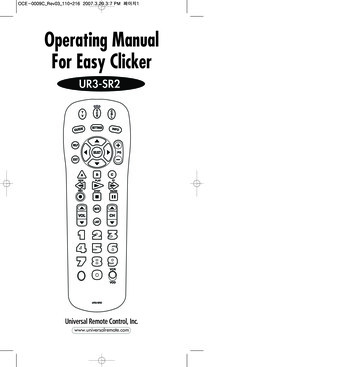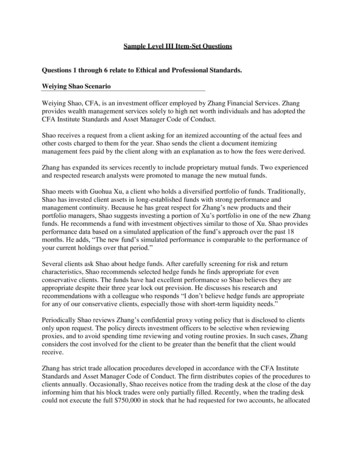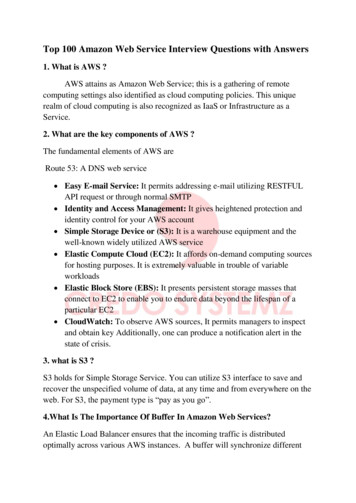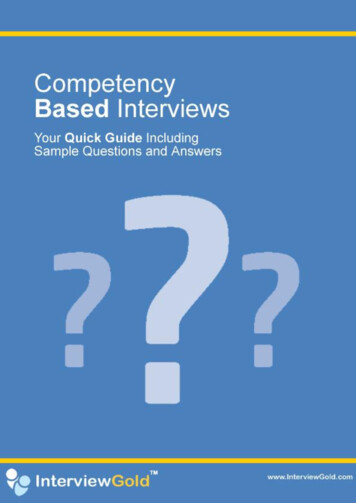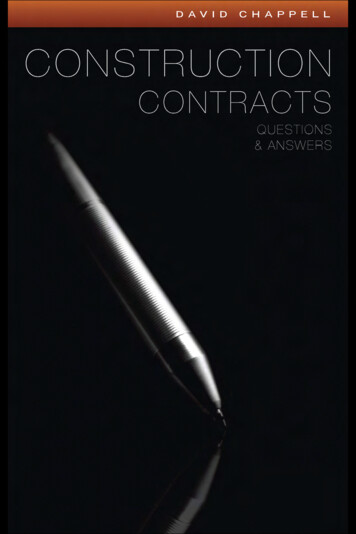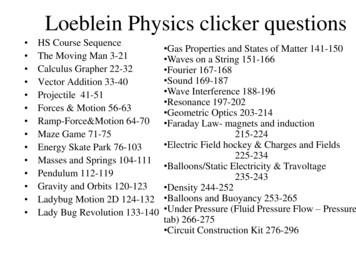
Transcription
Loeblein Physics clicker questions HS Course SequenceThe Moving Man 3-21Calculus Grapher 22-32Vector Addition 33-40Projectile 41-51Forces & Motion 56-63Ramp-Force&Motion 64-70Maze Game 71-75Energy Skate Park 76-103Masses and Springs 104-111Pendulum 112-119Gravity and Orbits 120-123Ladybug Motion 2D 124-132Lady Bug Revolution 133-140 Gas Properties and States of Matter 141-150 Waves on a String 151-166 Fourier 167-168 Sound 169-187 Wave Interference 188-196 Resonance 197-202 Geometric Optics 203-214 Faraday Law- magnets and induction215-224 Electric Field hockey & Charges and Fields225-234 Balloons/Static Electricity & Travoltage235-243 Density 244-252 Balloons and Buoyancy 253-265 Under Pressure (Fluid Pressure Flow – Pressuretab) 266-275 Circuit Construction Kit 276-296
Plans for using PhET simulation activities in Loeblein’s College PhysicsIC In Class Activity; CQ clicker questions; HW homework ; Demo: teacher centered group discussionSemester 1Unit 1: Introduction to Motion:Moving Man IC/CQCalculus Grapher HW/CQUnit 2: More on motion and MeasurementVector Addition IC/CQProjectile motion IC/CQUnit 3: Forces and the Laws of MotionPublishing skills: curve fit, drawing, tablesForces and Motion: Two activities IC/CQRamp- Force and Motion: Two activities IC/CQMaze Game: HW/CQCurve Fitting: HWUnit 4: Work, Energy, Momentum andCollisionsEnergy Skate Park: Four activities IC/CQMasses and Springs: IC/CQCollision: HWUnit 5: Circular Motion and Semester ProjectPendulum: HW/CQGravity Force Lab: IC/CQPendulum: HWLadybug 2D: HW/CQLadybug Revolution: HW/CQMasses and Springs: HWBalancing Act: (no activity yet)Semester 2Unit 1: Heat and ThermodynamicsFriction: DemoStates of matter: IC/CQUnit 2: Waves: Introduction to light and soundWaves on a String: IC/CQFourier-Making Waves: Three activities IC/CQ/HWSound: IC/CQWave Interference: IC/CQResonance: IC/CQBending Light: ICGeometric optics: IC/CQUnit 3: Electric and Magnetic Forces and FieldsFaraday’s Electromagnet Lab: IC/CQElectric Field Hockey with Charges and Fields: IC/CQBalloons and Static Electricity John Travoltage: Demo / CQGravity and Orbits: CQUnit 4: Fluid Mechanics, Semester ProjectsDensity: IC/CQBuoyancy: ICBalloons and Buoyancy: IC/CQUnder Pressure: IC/HW/CQEstimation: HWUnit 5: Current, Resistance, Circuits, and CircuitElementsCharges and Fields: DemoCapacitor Lab: HWCircuit Construction Kit: Three activities IC/CQ
The Moving ManActivityTrish Loeblein phet.colorado.eduLearning goals: Students will be able to accurately interpretand draw position, velocity and acceleration graphs forcommon situations and explain their reasoning.
1.Below is a graph of a balls motion.Which of the following gives the bestinterpretation of the ball’s motion?
a.The ball moves along a flat surface. Then itmoves forward down a hill, and then finally stops.b.The ball doesn’t move at first. Then it movesforward down a hill and finally stops.c.The ball is moving at constant velocity. Then itslows down and stops.d.The ball doesn’t move at first. Then it movesbackwards and then finally stops.e.The ball moves along a flat area, movesbackwards down a hill and then it keeps moving.
2. Draw a velocity-time graph would best depictthe following scenario?A man starts at the origin, walks back slowlyand steadily for 6 seconds. Then he standsstill for 6 seconds, then walks forwardsteadily about twice as fast for 6 seconds.
2 Which velocity time graph best depicts the scenario?
3. For the same scenario as # 2, which positiontime graph best depicts the motion?
4 A car is traveling along a road. Its velocity isrecorded as a function of time and is shown inthe graph below.
5.Which of the following position-timegraphs would be consistent with the motion ofthe car in question #4?
6. A car is moving forward and applying thebreak. Which position-time graph best depictsthis motion?
Stopping Distance. Consider two cars, a700kg Porsche and a 600kg Honda Civic.The Porsche is speeding along at 40 m/s(mph) and the Civic is going half the speedat 20 m/s. If the two cars brake to a stopwith the same constant acceleration, letslook at whether the amount of timerequired to come to a stop or the distancetraveled prior to stopping is influenced bytheir initial velocity.Perkins’ Phys1010 Homework 2 University of Colorado
Using Moving manSelect the accelerateoption and set the initialvelocity, initial position, andan acceleration rate so thatthe walking man’s motionwill emulate that of the carstopping with constantacceleration.
7. If you double the initial walkingspeed, the amount of time it takes tostopA.B.C.D.E.is six times longeris four times longeris two times longerdoes not changeis half as long
8. If you double the initial walkingspeed, the man walks beforecoming to a stop.A.B.C.D.E.Half the distancefour times fartherthree times farthertwo times fartherThe same distance
9. If you triple the initial walkingspeed, the walking man goes before stopping.A.B.C.D.E.one third as farOne ninth as farthree times farthersix times farthernine times farther
Notes from Perkins’ homeworkWhile moving man is useful to answer this question,equations give us the same result.Use Velocity Initial velocity acceleration x timeor acceleration (change in velocity)/(time elapsed)which is the same as (time elapsed) (change invelocity)/acceleration.So it will take 2 times as long to stop if the initialvelocity is 2 times larger and the acceleration is thesame.distance traveled (initial velocity) x time (1/2 xacceleration x time x time)Adapted From Perkins at University of Colorado
10. If the acceleration is zero, theman must be standing still.A. TrueB. False
11. Velocity and acceleration arealways the same sign (both positiveor both negative).A. TrueB. False
12. If the speed is increasing, theacceleration must be positive.A. TrueB. False
Notes from Perkins’ homeworkA negative acceleration indicates thatthe acceleration points in the negativedirection. Under these conditions, ifthe man is moving in the positivedirection, the negative acceleration willbe acting to slow him down (velocity andacceleration point in oppositedirections). If the man is moving in thenegative direction, the negativeacceleration will be acting to speed himup (velocity and acceleration point inthe same direction).Adapted From Perkins at CU 1010 course at University of Colorado
Calculus Grapher for PhysicsActivityLearning Goals: Students will be able to: Use the language of calculus to discuss motion Given a function sketch the derivative, orintegral curvesOpen Calculus Grapher and Moving Man before starting presentationTrish Loeblein July 2009phet.colorado.edu
1. A car started from a stoplight,then sped up to a constant speed.This function graph describes his.A.PositionB.VelocityC.Acceleration
Use Moving man to show this: I set the acceleration at about 3then paused the sim by the time the man got to the 4 spot, then Ichanged the acceleration to 0. If you have Moving man open withthis type of scenario, you can use the grey bar to show that thespeed was zero increasing and then constant.
2. To find out howfar he traveled, youwould useA.IntegralB.FunctionC.Derivative
Use Moving Man Replay to showPosition is found by the integralcurveDerivative curve shows acceleration
3. Your friend walks forward at a constant speedand then stops. Which graph matches her motion?A. Position curveC. Position curveB. Velocity curveD. Acceleration curveE. More than one of these
Use Moving man toshow this: I set theMan at about -6position, made thevelocity about 4, thenpaused the sim by thetime the man got to the4 spot, then I changedthe velocity to 0. If youhave Moving manopen with this type ofscenario, you can usethe grey bar to help.
4. Which could be thederivative curve?AF(x)BC
PedestalLinearParabolaF(x)For each case, if the function, F(x) isvelocity, what could a possible story for themotion of a person walking?
5. Three race cars have thesevelocity graphs. Which oneprobably wins?ABCD No wayto tell
Max valueUse integral totell that theparabolic onetraveledfarthest
Vector additionActivityLearning Goals: Students will be able to Explain vector representations in their ownwords Convert between the of angular form ofvectors and the component formAdd vectors.Trish Loeblein phet.colorado.edu
1. For one hour, you travel east in your carcovering 100 km .Then travel south 100 km in2 hours. You would tell your friends that youraverage speed wasA.B.C.D.E.47 km/hr67 km/hr75 km/hr141 km/hr200 km/hr
2. For one hour, you travel east in your carcovering 100 km .Then travel south 100km in 2 hours. You would tell yourfriends that your average velocity wasA.B.C.D.E.47 km/hr67 km/hr75 km/hr141 km/hr200 km/hr
3. You have already traveled east in your car 100 kmin 1 hr and then south 100 km in 2 hrs. To get backhome, you then drive west 100 km for 3 hours andthen go north 100 km in 4 hours. You would sayyour average velocity for the total trip wasA. 20 km/hrB. 40 km/hrC. 60 km/hrD. 100 km/hrE. None of the above
4. You fly east in an airplane for 100 km. You thenturn left 60 degrees and travel 200 km. How fareast of the starting point are you? (approximately)A.100 kmB. 150 kmC. 200 kmD.300 kmE. none of the above
5. You fly east in an airplane for 100 km. Youthen turn left 60 degrees and fly 200 km. How farnorth of the starting point are you? (approximately)A.100 kmB. 130 kmC. 170 kmD.200 kmE. none of the above
6. You fly east in an airplane for 100 km. Youthen turn left 60 degrees and fly 200 km. Howfar from the starting point are you? (approximately)A.170 kmB. 200 kmC. 260 kmD.300 kmE. 370 km
7. You fly east in an airplane for 100 km. Youthen turn left 60 degrees and fly 200 km. Inwhat direction are you from the starting point?A. South of westB. Directly southwestC. Directly northeastD. North of eastE. None of the above
Projectile MotionActivityTrish LoebleinJune 08Download the lesson plan and studentdirections for the lab HEREThere are some screen shots included toillustrate answers, but it would be better touse the simulation during discussion.phet.colorado.edu
Learning Goals Predict how varying initial conditionseffect a projectile pathThese are part of the lesson, but not addressed in theclicker questions: Use reasoning to explain the predictions. Explain projectile motion terms in their ownwords. Describe why using the simulation is a goodmethod for studying projectiles.
1. Which car will go farther?ABC They willgo the samedistance
2. Which will be in the air longer?ABC same timein air
3. Which car will go higher?ABC They willgo the sameheight
(angleonlyvariation)Time for 75 degrees 3.6 s, 35 degrees 2.2
4. Which will go farther?ABC They will gosame distance
5. Which will go farther? ABC They will gosame distance
6. Which will go higher? ABC They will gosame height
7. Which will go farther? ABC They will gosame distance
Results 4-7 Small vs large objectRed paths have air resistanceWithout air resistance no differenceShell drag .05Buick drag 1.3 ShellBuick shown(Shell hasidentical paths)SmallShell
Forces & MotionActivity 1Trish Loeblein phet.colorado.edu Learning Goals: Students will be able to Predict, qualitatively, how an external force will affectthe speed and direction of an object's motion Explain the effects with the help of a free body diagram Explain the difference between static friction, kineticfriction and friction force. This goal is not addressed inthe student directions, but is part of the post-lesson.
Crate was moving to Then, the guythe rightpushed the crate1. If the total force acts in the same direction asthe crate is sliding, the crateA. slows downB. speeds upC. remains at same speedD. slows down, changes direction and thenspeeds up going the other wayE. remains at same speed, but changes direction
Cabinet was moving Then, the guyto the leftpushed the cabinet2. If the total force acts in the opposite direction asthe cabinet is sliding, the cabinet wouldA. slow downB. speed upC. remain at same speedD. slow down, change direction and thenspeed up going the other wayE. remain at same speed, but changedirection
Refrigerator wasmoving to the rightThen, the guy pushedthe refrigerator3. If there is zero total force acting on on therefrigerator, the refrigerator wouldA. slow downB. speed upC. remain at same speedD. slow down, change direction and then speedup going the other wayE. remain at same speed, but change direction
Forces & MotionActivity 2Trish Loeblein phet.colorado.eduLearning Goals: Students will be able to: Use free body diagrams to draw position, velocity,acceleration and force graphs and vice versa Explain how the graphs relate to one another. Given a scenario or a graph, sketch all four graphs
1. A car is traveling along aroad. Its acceleration is recordedas a function of time.accelerationtime
1. Which Total force-time graphwould best match the scenario?ABforceforcetimeCforcetimetime
2. A cabinet is speeding up as itslides right across the room. Whichof the following is a possible freebody diagram?ABC
3. A car is traveling along aroad. Its velocity is recordedas a function of time.
3. Which would be theTotal force-time graph?ABforceforcetimeCforcetimetime
4. A car is moving towardsthe right. Then a force isapplied and the free bodydiagram looks like thisForcediagramDraw what you think the positiontime graph would look like.
4. Which position-time graphbest matches your idea?
Ramp- Force and MotionActivity 1If you want to make questions like I have where onlyone variable changes and you see what changes on thediagram: Play with the sim until you get a diagramyou like. (you can go pass the spot) Pause the sim.Use the vertical bar to go back to a spot t
The Moving Man Activity Learning goals: Students will be able to accurately interpret and draw position, velocity and acceleration graphs for common situations and explain their reasoning. Trish Loeblein phet.colorado.edu
